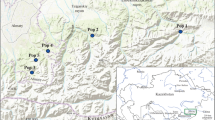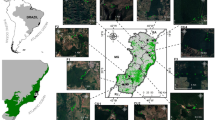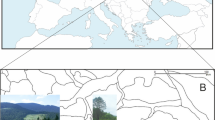Abstract
The objective of this study was to evaluate the genetic diversity and population structure of natural subpopulations of Paspalum rawitscheri (Parodi) Chase ex G.H. Rua & Valls using inter-simple sequence repeat (ISSR) molecular markers. Four natural subpopulations from State of Rio Grande do Sul, Brazil, were evaluated, using six ISSR primers. A total of 131 fragments were amplified, 34 of which were polymorphic. The genetic diversity (h) for the subpopulations was considered low, with values ranging from 0.130 to 0.217. The Vacaria subpopulation presented the lowest diversity among populations. The Shannon (I) diversity indices were also low, with values ranging from 0.187 to 0.334, with the Vacaria subpopulation also presenting the lowest values. The molecular variance (AMOVA) analysis showed, in general, the highest variation occurred within subpopulations rather than between subpopulations. The Bayesian Inference analysis separated the individuals into four genetic clusters, mixing individuals from different municipalities in the clusters. The results indicate that the species has low genetic diversity and low population structure, requiring conservation plans. Ex situ conservation becomes a necessary effort, since populations of this species are found in grasslands remnants affected by fires and implantation of crops, and is not present in any protected area of the Brazilian Conservation Units system.




Similar content being viewed by others
References
Alam A, Naik PK, Gulati P, Gulati AK, Mishra GP (2008) Characterization of genetic structure of Podophyllum hexandrum populations, an endangered medicinal herb of Northwestern Himalaya, using ISSR-PCR markers and its relatedness with podophyllotoxin content. Afr J Biotechnol 7:1028–1040. https://doi.org/10.4314/ajb.v7i8.58599
Batista LAR, Godoy R (2000) Caracterização preliminar e seleção de germoplasma do gênero Paspalum para a produção de forragem. R Bras Zoot 29:23–32. https://doi.org/10.1590/S1516-35982000000100004
Brasil. 2014. Lista Nacional Oficial de Espécies da Flora Ameaçadas de Extinção. Diário Oficial, Decreto 6.101. http://cncflora.jbrj.gov.br/portal/static/pdf/portaria_mma_443_2014.pdf. Acessed 9 Mar 2020
CidadeDall’Agnol FWM, Bered F, Souza-Chies TT (2008) Genetic diversity of the complex Paspalum notatum Flügge (Paniceae: Panicoideae). Genet Resour Crop Ev 55:235–246. https://doi.org/10.1007/s10722-007-9231-8
CNC Flora (Centro Nacional de Conservação da Flora). http://cncflora.jbrj.gov.br/portal/pt-brAcessed 29 Aug 2020
Denham SS, Zuloaga FO (2007) Phylogenetic Relationships of the Decumbentes Group of Paspalum, Thrasya, and Thrasyopsis (Poaceae: Panicoideae: Paniceae). J Syst Evol Bot 23:545–562. https://doi.org/10.5642/aliso.20072301.41
Doyle JJ, Doyle JL (1987) A rapid DNA isolation procedure for small quantities of fresh leaf tissue. Phytochem Bull 19:11–15
Earl DA, von Holdt BM (2012) Structure Harvester: a website and program for visualizing Structure output and implementing the Evanno method. Conserv Genet Resour 4:359–361. https://doi.org/10.1007/s12686-011-9548-7
Essi L, Lima MFRC, Leite LGL, Wolf MM. Threatened and understudied: the lack of genetic data of endangered Brazilian plant species. CeN. (in press)
George S, Sharma J, Yadon VL (2009) Genetic diversity of the endangered and narrow endemic Piperia yadonii (Orchidaceae) assessed with ISSR polymorphisms. Am J Bot 96:2022–2030. https://doi.org/10.3732/ajb.0800368
Jangjoo M, Matter SF, Roland J, Keyghobadi N (2016) Connectivity rescues genetic diversity after a demographic bottleneck in a butterfly population network. PNAS 113:10914–10919. https://doi.org/10.1073/pnas.1600865113
Liu J, Shi S, Chang E, Yang W, Jiang Z (2013) Genetic diversity of the critically endangered Thuja sutchuenensis revealed by ISSR markers and the implications for conservation. Int J Mol Sci 14:14860–14871. https://doi.org/10.3390/ijms140714860
Maciel JR, Oliveira RC, Sousa MWDS, Pimenta KM, Moura CO, Rua GH, Valls JFM. 2020. Paspalum in Flora do Brasil 2020 em construção. Jardim Botânico do Rio de Janeiro. http://floradobrasil.jbrj.gov.br/reflora/floradobrasil/FB127893 Acessed 15 Jul 2020
Martinelli G, Moraes MA (2013) Livro Vermelho da flora do Brasil. Instituto de Pesquisas Jardim Botânico do Rio de Janeiro, Rio de Janeiro
Motta EAM, Dall’Agnol M, Nascimento FL et al (2016) Forage performance of Paspalum hybrids from an interspecific cross. Cienc Rural 46:1025–1031. https://doi.org/10.1590/0103-8478cr20150232
Oliveira RC, Valls JFM. 2015. Paspalum em Lista de Espécies da Flora do Brasil. Jardim Botânico do Rio de Janeiro. http://floradobrasil.jbrj.gov.br/jabot/floradobrasil/FB127893. 09 de março de 2020.
Oliveira RC, Valls JFM (2002) Taxonomia de Paspalum L., grupo Linearia (Gramineae—Paniceae) do Brasil. Rev Bras Bot 25:371–389. https://doi.org/10.1590/S0100-84042002012000001
Pavlova A, Beheregaray LB, Coleman R et al (2017) Severe consequences of habitat fragmentation on genetic diversity of an endangered Australian freshwater fish: a call for assisted gene flow. Evol Appl 10:531–550. https://doi.org/10.1111/eva.12484
Peakall R, Smouse PE (2012) GenAlEx 6.5: genetic analysis in Excel. Population genetic software for teaching and research-na update. Bioinform 28:2537–2539. https://doi.org/10.1093/bioinformatics/bts460
Pereira EA (2013) Melhoramento genético por meio de hibridizações interespecíficas no grupo Plicatula - gênero Paspalum Tese de doutorado. Universidade Federal do Rio Grande do Sul, Porto Alegre
Pereira EA, Barros T, Volkmann GK, Battisti GK, Silva JAG, SimioniDall’Agnol CM (2012) Variabilidade genética de caracteres forrageiros em Paspalum. Rev Agropec Bras 47:1533–1540. https://doi.org/10.1590/S0100-204X2012001000017
Pinheiro LR, Rabbani ARC, Silva AVC, Lédo AS, Pereira KLG, Diniz LEC (2012) Genetic diversity and population structure in the Brazilian Cattleya labiata (Orchidaceae) using RAPD and ISSR markers. Plant Syst Evol 298:1815–1825. https://doi.org/10.1007/s00606-012-0682-9
Poaceae in Flora do Brasil 2020 em construção. Jardim Botânico do Rio de Janeiro. http://floradobrasil.jbrj.gov.br/reflora/floradobrasil/FB193 Acessed 29 Aug 2020.
Pritchard JK, Stephens M, Donnelly P (2000) Inference of population structure using multilocus genotype data. Genetics 155:945–959
Reisch C, Poschlod P, Wingender R (2003) Genetic differentiation among populations of Sesleria albicans Kit. ex Schultes (Poaceae) from ecologically different habitats in central Europe. Heredity 91:519–527. https://doi.org/10.1038/sj.hdy.6800350
Reyno R, Narancio R, Speranza P, Canto J, López-Carro B, Hernández P, Burgueño J, Real D, Rizza MD (2012) Molecular and cytogenetic characterization of a collection of bahiagrass (Paspalum notatum Flügge) native to Uruguay. Genet Resour Crop Ev 59:1823–1832. https://doi.org/10.1007/s10722-012-9806-x
Ribeiro BR, Martins E, Martinelli G, Loyola R (2018) The effectiveness of protected areas and indigenous lands in representing threatened plant species in Brazil. Rodriguésia 69:1539–1546. https://doi.org/10.1590/2175-7860201869404
Ribeiro PCC, Pinheiro LC, Domingues R, Forzza RC, Machado MA, Viccini LF (2013) Genetic diversity of Vriesea cacuminis (Bromeliaceae): and endangered and endemic Brazilian species. Genet Mol Res 12:1934–1943. https://doi.org/10.4238/2013.June.13.2
Rio Grande do Sul. 2014. Táxons da flora nativa do Estado Rio Grande do Sul ameaçadas de extinção. Diário Oficial, Decreto 52.109. http://www.al.rs.gov.br/filerepository/repLegis/arquivos/DEC%2052.109.pdf. Acessed 9 Mar 2020.
Rodrigues JF (2010) Delimitação de espécies e diversidade genética no complexo Cattleya coccinea Lindl. e C. mantiqueirae (Fowlie) van den Berg (Orchidaceae) baseada em marcadores moleculares ISSR. Dissertação de mestrado, Escola Superior da Agricultura “Luiz de Queiroz”, Piracicaba, Brasil.
Rodrigues L, Bergvd C, Póvoa O, Monteiro A (2013) Low genetic diversity and significant structuring in the endangered Mentha cervina populations and its implications of conservation. Biochem Syst Ecol 50:51–61. https://doi.org/10.1016/j.bse.2013.03.007
Rua GH, Speranza PR, Vaio M, Arakaki M (2010) A phylogenetic analysis of the genus Paspalum (Poaceae) based on cpDNA and morphology. Plant Syst Evol 288:227–243. https://doi.org/10.1007/s00606-010-0327-9
Rua GH, Valls JFM (2012) On the taxonomic status of the genus Thrasyopsis (Poaceae, Panicoideae, Paspaleae): new combinations in Paspalum. Phytotaxa 73:60–66. https://doi.org/10.11646/phytotaxa.73.1.7
Sawasato JT, Dall’Agnol M, Conceição DP, Tafernaberri Júnior V, Klafke GB (2008) Utilização de microssatélites e RAPD na caracterização molecular de acessos de Paspalum urvillei Steudel. Rev Bras Zoot 37:1366–1374. https://doi.org/10.1590/S1516-35982008000800005
Setubal RB, Boldrini II (2010) Floristic and Characterization of Grassland Vegetation at a Granitic Hill in Southern Brazil. Rev Bras Biociências 8:85–111
Singh N (2016) Studies on genetic diversity of kodo millets (Paspalum scrobiculatum L.) using Random Amplified Polymorphic DNA (RAPD) and Inter Simple Sequence Repeat Markers (ISSR). Theses, Jawaharlal Nehru Krishi Vishwa Vidyalaya, Jabalpur
Souza-Chies TT, Essi L, Rua GH, Valls JFM, Miz RB (2006) A preliminary approach to the phylogeny of the genus Paspalum (Poaceae). Genetica 126:15–32. https://doi.org/10.1007/s10709-005-1428-1
Valle JS, Fonseca BKD, Nakamura SS (2013) Diversidade genética de populações naturais de pariparoba [Pothomorphe umbellata (L.) Miq.] por RAPD. Rev Bras Plantas Med 15:47–53. https://doi.org/10.1590/S1516-05722013000100006
Wu C, Cheng Z, Huang X, Yin S, Cao K, Sun C (2004) Genetic diversity among and within populations of Oryza granulata from Yunnan of China revealed by RAPD and ISSR markers: implications for conservation of the endangered species. Plant Sci 167:35–42. https://doi.org/10.1016/j.plantsci.2004.02.022
Wu FQ, Shen SK, Zhang XJ, Wang YH, Sun WB (2015) Genetic diversity and population structure of an extremely endangered species: the world’s largest rhododendron. AoB Plants 7:plu082. https://doi.org/10.1093/aobpla/plu082
Yadav Y, Lavanya GR, Pandey S, Verma M, Ram C, Arya L (2016) Neutral and functional marker based genetic diversity in kodo millet (Paspalum scrobiculatum L). Acta Physiol Plant 38:1–12. https://doi.org/10.1007/s11738-016-2090-1
Zhang Z, Chen Y, Li D (2005) Detection of low genetic variation in a critically endangered chinese pine, Pinus squamata, using RAPD and ISSR markers. Biochem Genet 23:239–249. https://doi.org/10.1007/s10528-005-5215-6
Zietkiewicz E, Rafalski A, Labuda D (1994) Genome fingerprinting by simple sequence repeat (ssr) – anchored polymerase chain reaction amplification. Genomics 20:176–183. https://doi.org/10.1006/geno.1994.1151
Zilli AL, Hojsgaard DH, Brugnoli EA (2014) Genetic relationship among Paspalum species of the subgenus Anachyris: Taxonomic and evolutionary implications. Flora 209:604–612. https://doi.org/10.1016/j.flora.2014.08.005
Zuloaga FO, Morrone O (2005) Revisión de las espécies de Paspalum para America del Sur Austral (Argentina, Bolívia, Sur del Brasil, Chile, Paraguay y Uruguay). Monogr Syst Bot Mo Bot Gard 102:1–297
Acknowledgements
The authors thank the Coordenação de Aperfeiçoamento de Pessoal de Nível Superior (CAPES) for the fellowship for the first author, and the Department of Biology of the Universidade Federal de Santa Maria for the financial support on the field trips. We also thank Prof. Dr. Zaida Ines Antoniolli and her lab team for their support.
Author information
Authors and Affiliations
Contributions
All authors contributed to the study conception and design. Plant collection, material preparation, data collection and analysis were performed by the first and second authors. The first draft of the manuscript was written by the first author and all authors commented on previous versions of the manuscript. All authors read and approved the final manuscript.
Corresponding author
Additional information
Publisher's Note
Springer Nature remains neutral with regard to jurisdictional claims in published maps and institutional affiliations.
Rights and permissions
About this article
Cite this article
de Freitas, J.M.B., Essi, L. & Tedesco, S.B. Genetic diversity and population structure of natural populations of the endangered grass Paspalum rawitscheri (Parodi) Chase ex G.H. Rua & Valls (Paspaleae, Poaceae). Braz. J. Bot 44, 401–409 (2021). https://doi.org/10.1007/s40415-021-00699-8
Received:
Revised:
Accepted:
Published:
Issue Date:
DOI: https://doi.org/10.1007/s40415-021-00699-8




